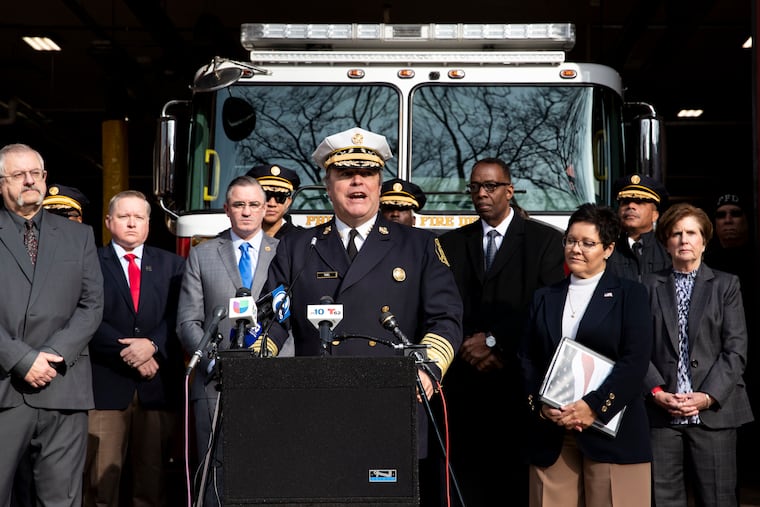Federal fire officials came to Philly to honor the anniversary of the deadly Fairmount fire and unveil a new national strategy
In 2022, there were 1.2 million structure fires in the country that led to 2,500 deaths — 276 of them children.

Marking the one-year anniversary of the Fairmount blaze that killed 12 people, nine of them children, the nation’s top fire official visited Philadelphia to unveil a strategy to combat fire threats across the country.
Lori Moore-Merrell, the U.S. fire administrator appointed by President Joe Biden, said the plan comes amid indifference to deadly fires, including the government’s failure to collect reliable fire data and a lack of attention to safety codes by building developers.
“We honor those who were lost, and mourn for their families, and we stand together today to tell you that fire remains a serious threat to public safety — and America is still burning,” Moore-Merrell said during a news conference outside the Philadelphia Fire Department’s Engine Company 8 in Old City on Wednesday.
It didn’t take long for that urgency to manifest. As Moore-Merrell took questions, the fire station’s crisp alarm bell cut through her remarks. About a third of the fire team standing behind the lectern sprang into action, rushing toward a fire engine and flipping on the siren before disappearing into the traffic down Arch Street.
Somewhere, help was needed.
Moore-Merrell backed up her concern with sobering statistics. In 2022, there were 1.2 million structure fires in the country that led to 2,500 deaths — 276 of them children.
Along with “tens of thousands” of injuries, Moore-Merrell said those fires resulted in the deaths of 96 firefighters and disproportionately affected vulnerable communities, including the elderly, children, and low-income residents.
In Philadelphia, the Fairmount fire’s victims were among 41 people who died from fires last year, according to Philadelphia Fire Commissioner Adam Thiel, who said fires led to 200 injuries, with thousands displaced from their homes, and full beds at the region’s two burn centers.
Biden signed federal legislation last month that grants the U.S. Fire Administration, an arm of the Federal Emergency Management Agency, unprecedented investigative powers into deadly fires similar to the Fairmount fire, one of Philadelphia’s worst in a generation. The bill also allows the agency to identify at-risk buildings and issue safety recommendations.
“The building fails us before firefighters even arrive,” Moore-Merrell said. “So we want to know what are the aspects of the buildings that have led to deaths in those buildings that could have been prevented — and bought more time for either escape, or firefighters to rescue people.”
Philadelphia was the second stop for Moore-Merrell, who touted the plan in New York on Monday as that city marks the one-year anniversary of a fire that killed 17 people in a Bronx apartment complex.
A need for code enforcement was apparent during the Fairmount fire, which tore through the upper stories of a Philadelphia Housing Authority building on the frigid morning of Jan. 5 last year.
Investigators attributed the blaze to a child playing with a lighter near a Christmas tree, and determined that only one fire alarm had been working at the time, located in the building’s basement.
The remaining alarms were removed or their batteries had been taken out, investigators found. In the aftermath of the blaze, PHA said it has worked with its residents to hold fire drills and put in place emergency safety plans.
Because the recently signed federal legislation is not retroactive, the USFA will not be investigating the Fairmount fire.
Lorraine Carli, vice president of outreach and advocacy for the National Fire Protection Association, explained that officials would help local jurisdictions enforce the NFPA’s 300-plus fire codes as residential structures nationwide struggled with outdated safety systems.
Already there’s been some headway. Last month, Biden signed a bill introduced by Pennsylvania Sen. Bob Casey and inspired by the Fairmount fire, which mandates the installation of tamper-resistant fire alarms in public housing units.
Carli lauded Congress’ 1992 mandate of sprinklers in newly constructed multifamily housing units. However, HUD estimated that of more than 500,000 units constructed before this date, a “significant” number had no sprinklers installed.
Thiel said Philadelphia was fortunate for its ordinance mandating sprinkler systems in newer buildings, and commended efforts to retrofit older complexes.
Take the recent fire in the basement of historic Carpenters Hall at Independence National Historical Park. Thiel said that during the Christmas Eve blaze, a sprinkler system activated and gave fire crews enough time to get inside and extinguish the fire.
However, Thiel said high-rises “within a stone’s throw” of Wednesday’s news conference were without sprinklers, with some estimating that it could cost between $800,000 and $4 million to retrofit a 400,000-square-foot high-rise.
Dan Madrykowski, director of the Fire Safety Research Institute, said that fires are burning faster in recent years due to flammable synthetic materials being increasingly common in home furnishings. That can turn a small flame into a “flashover” — near-instant combustion — in minutes.
Madrykowski also cited lithium batteries, used in e-bikes and scooters, that when damaged can transition from “smoking to explosive fire behavior” within seconds.